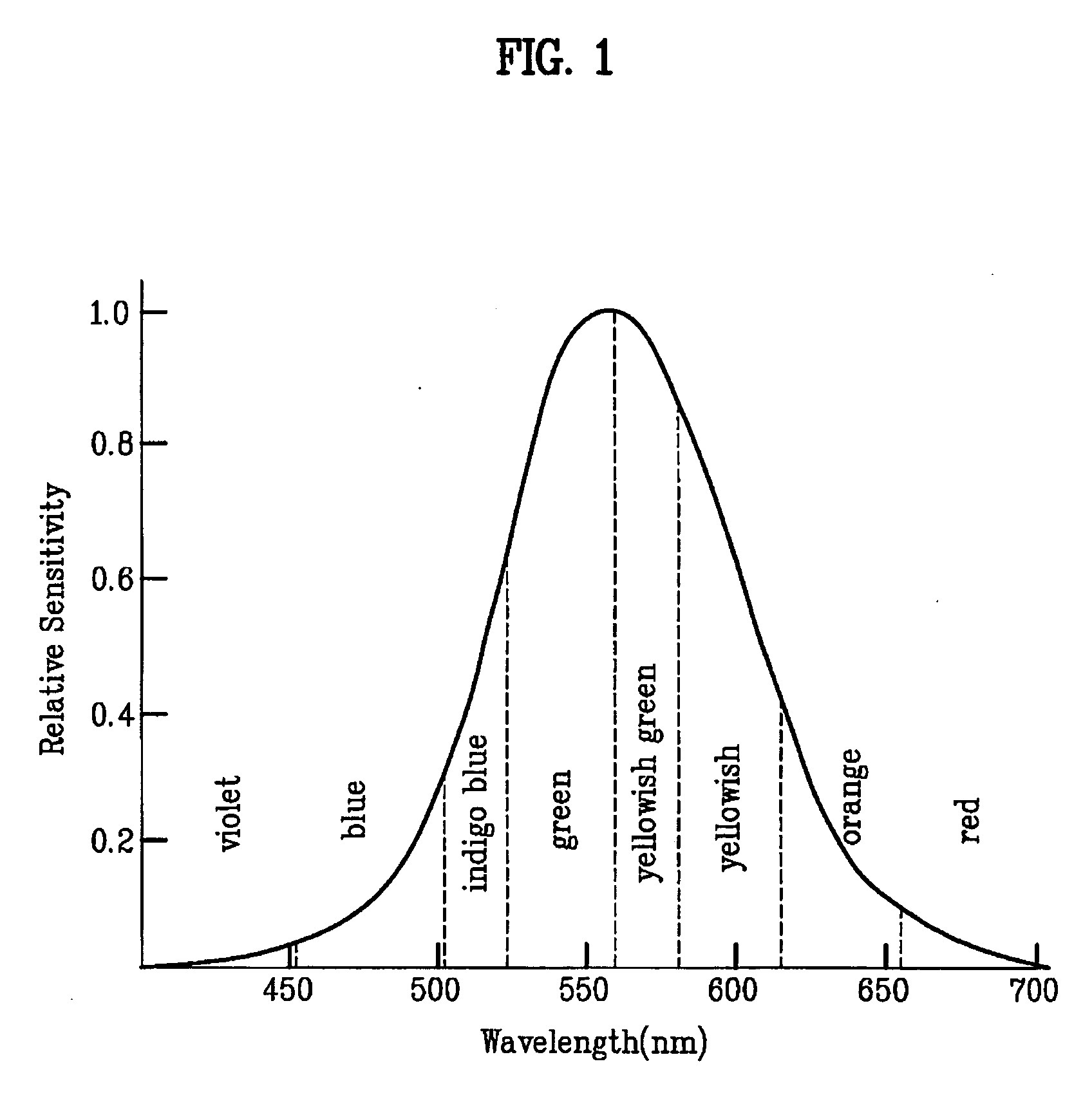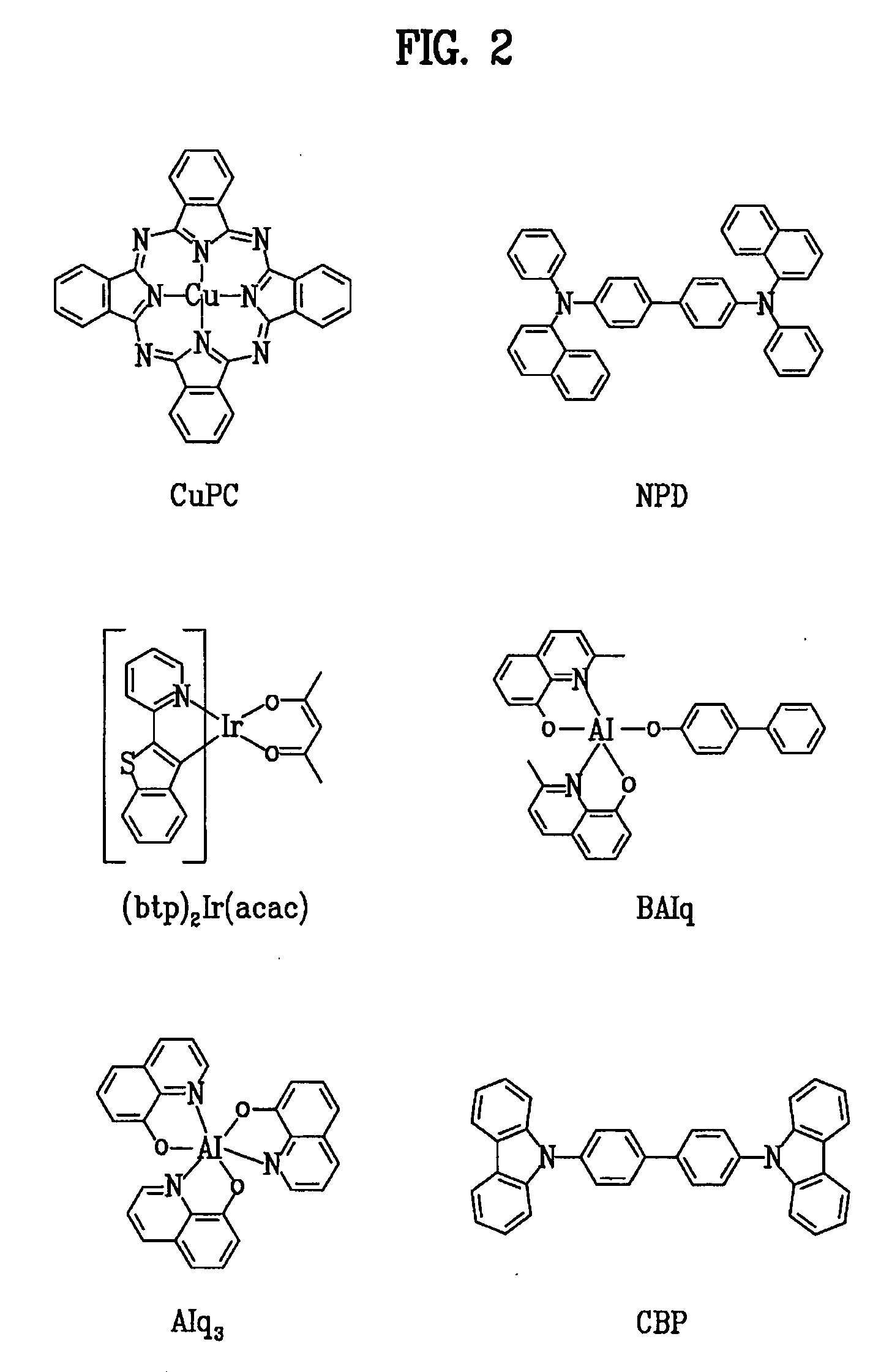Red phosphorescent compound and organic electroluminescent device using the same
a technology of red phosphorescent compound and organic electroluminescent device, which is applied in the direction of discharge tube luminescnet screen, other domestic articles, natural mineral layered products, etc., can solve the problems of reducing the spectral the difficulty of achieving high luminescence efficiency of the organic el device, etc., to achieve high luminance, long life, and high color purity
- Summary
- Abstract
- Description
- Claims
- Application Information
AI Technical Summary
Benefits of technology
Problems solved by technology
Method used
Image
Examples
synthesis examples
1. Synthesis of 2-(3-methylphenyl)-6-metoxyquinoline
[0032]
[0033] 3-Methylphenyl borate (1.3 mmol), 2-chloro-6-methoxyquinoline (1 mmol), tetrakis(triphenylphosphine) palladium(O) (0.05 mmol) and potassium carbonate (3 mmol) were dissolved in THF (30 mL) and H2O (10 mL). The resulting solution was stirred in a bath at 100° C. for 24 hours. After completion of the reaction, the solvents were removed. The reaction mixture was extracted with dichloromethane and water and distilled under reduced pressure. The resulting residue was purified by silica gel column chromatography. The eluate was distilled under reduced pressure. The residue was recrystallized from dichloromethane and petroleum ether, and filtered to yield 2-(3-methylphenyl)-6-methoxyquinoline as a solid.
2. Synthesis of dichloro-crosslinked dimer complex
[0034]
[0035] Iridium (III) chloride hydrate (1 mmol) , the 2-(3-methylphenyl)-6-methoxyquinoline (2.5 mmol) and a mixed solvent (30 mL) of 2-ethoxyethanol and distilled wate...
example 1
[0039] An ITO-coated glass substrate was patterned to have a light-emitting area of 3 mm×3 mm, followed by cleaning. After the patterned substrate was disposed in a vacuum chamber, the standard pressure of the chamber was adjusted to 1×10−6 torr. CuPc (200 Å), NPD (400 Å), BAlq+A-2 (7%) (200 Å), Alq3 (300 Å), LiF (5 Å) and Al (1000 Å) were sequentially deposited on the ITO glass substrate to fabricate an organic EL device.
[0040] The luminance of the organic EL device was 1,052 cd / m2 at an electric current of 0.9 mA and a voltage of 6.5 V. At this time, the CIE chromaticity coordinates were x=0.648 and y=0.349. The lifetime (defined as the time taken before the luminance of the organic EL device decreases to half its initial value) of the organic EL device was 4,300 hours at 2,000 cd / m2.
example 2
[0041] An ITO-coated glass substrate was patterned to have a light-emitting area of 3 mm×3 mm, followed by cleaning. After the patterned substrate was disposed in a vacuum chamber, the standard pressure of the chamber was adjusted to 1×10−6 torr. CuPc (200 Å), NPD (400 Å), BAlq+A-6 (7%) (200 Å), Alq3 (300 Å), LiF (5 Å) and Al (1000 Å) were sequentially deposited on the ITO glass substrate to fabricate an organic EL device.
[0042] The luminance of the organic EL device was 1,095 cd / m2 at an electric current of 0.9 mA and a voltage of 6.2 V. At this time, the CIE chromaticity coordinates were x=0.651 and y=0.337. The lifetime (defined as the time taken before the luminance of the organic EL device decreases to half its initial value) of the organic EL device was 4,500 hours at 2,000 cd / M2.
PUM
| Property | Measurement | Unit |
|---|---|---|
| Percent by mass | aaaaa | aaaaa |
| Current | aaaaa | aaaaa |
| Electric potential / voltage | aaaaa | aaaaa |
Abstract
Description
Claims
Application Information
 Login to View More
Login to View More - R&D
- Intellectual Property
- Life Sciences
- Materials
- Tech Scout
- Unparalleled Data Quality
- Higher Quality Content
- 60% Fewer Hallucinations
Browse by: Latest US Patents, China's latest patents, Technical Efficacy Thesaurus, Application Domain, Technology Topic, Popular Technical Reports.
© 2025 PatSnap. All rights reserved.Legal|Privacy policy|Modern Slavery Act Transparency Statement|Sitemap|About US| Contact US: help@patsnap.com



